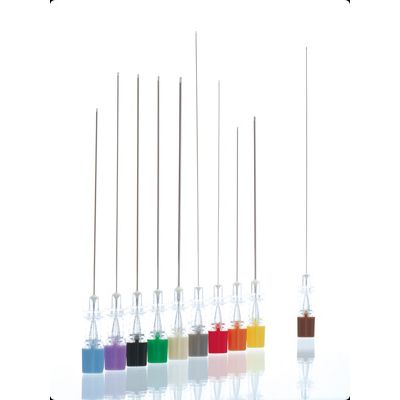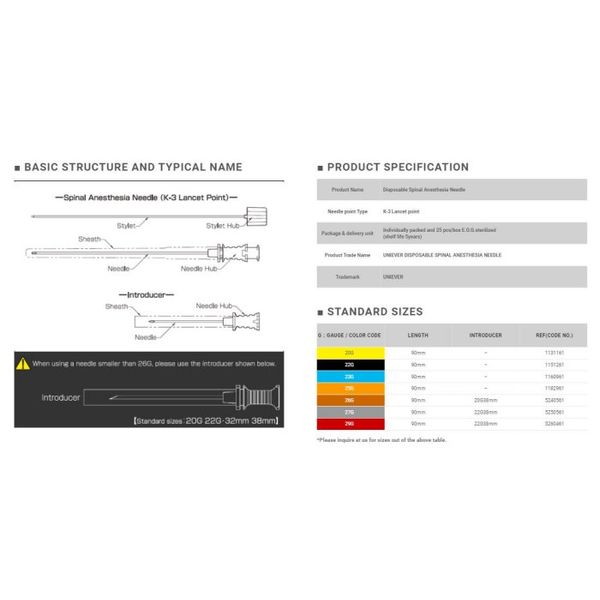

- Home
- Companies
- Unisis Corporation Japan
- Products
- UNIEVER - Model K-3 Lancet point - ...

UNIEVER - Model K-3 Lancet point - Disposable Spinal Anesthesia Needles
Spinal needle continues to set the global standard in a rapidly evolving category. This is the standard spinal needle with a conventional Quincke point, featuring excellent cutting performance and easy manipulation, ensuring successful procedures. It is available in a wide variety of sizes at reasonable prices to support different purposes and procedures.

Our crystal-clear polycarbonate hub allows easy visualization of CSE flashback. Scientifically designed hub provides you a secure grip during a procedure. A carefully designed and molded hub provides world class performance for the rapid flush back of CSF. Our strict QC procedures guarantee perfect fitting of stylet and needle hubs, which prevents needle wobbling.
Slight deviation of stylet/needle bevel angle is intended to minimize dural damages. We pay careful attention to the assembly of the needle and stylet in order to avoid problems like tissues jammed between the bevels.
Our recent application of unique thin-walled materials has resulted in an inner diameter 30% larger compared to our previous model.
You’ll see consistently fast CSF flush back thanks to this maximum lumen and our innovative hub design.
25 gauge K-3 lancet spinal anesthesia needle
The Unisis Quincke type anesthesia needle provides an optimum puncture resistance.
The precise and deliberate design of the stylet and needle allows the needle to pass smoothly through the arachnoid mater.
Allowing rapid backflow of CSF is an important factor in the performance of a spinal anesthesia needle, as it should confirm proper placement and reduce the risk of erroneous nerve puncture or other complications.
Unisis’s spinal anesthesia needles facilitate rapid CSF backflow because of the superior design of the needle hub, which has been rated highly among doctors.
The K-3 Lancet needle has a cutting point, and therefore it is more invasive than a non-cutting needle. This has the potential to increase the risk of CSF leak from the subarachnoid puncture.
The precise design of the needle tip of the UnisisK-3 Lancet point spinal anesthesia needle minimizes the invasiveness of the cutting point and can reduce the likelihood of CSF leak.
Spinal anesthesia is a technique that temporarily blocks spinal autonomic, sensory, and motor nerves by injection of an anesthetic agent into the cerebrospinal fluid of the subarachnoid space. The anesthesia is usually injected through the lumbar spine, below L2, to avoid risk of puncture to the spinal cord. Spinal anesthesia is safe and easy to perform, and it is widely used not only in the anesthesia department but also in the surgery, obstetric, and orthopedic departments. A benefit of this technique is that a small quantity of anesthetic agent can take effect almost immediately at the site where its effects are required. A drawback is that surgical time is limited by duration of action of the anesthetic agent and that the surgery is possible only in the affected site.
- Appendectomy
- Caesarean section
- Treatment of the anal and perineal area
- Severe low back pain
- Lower extremity fracture
